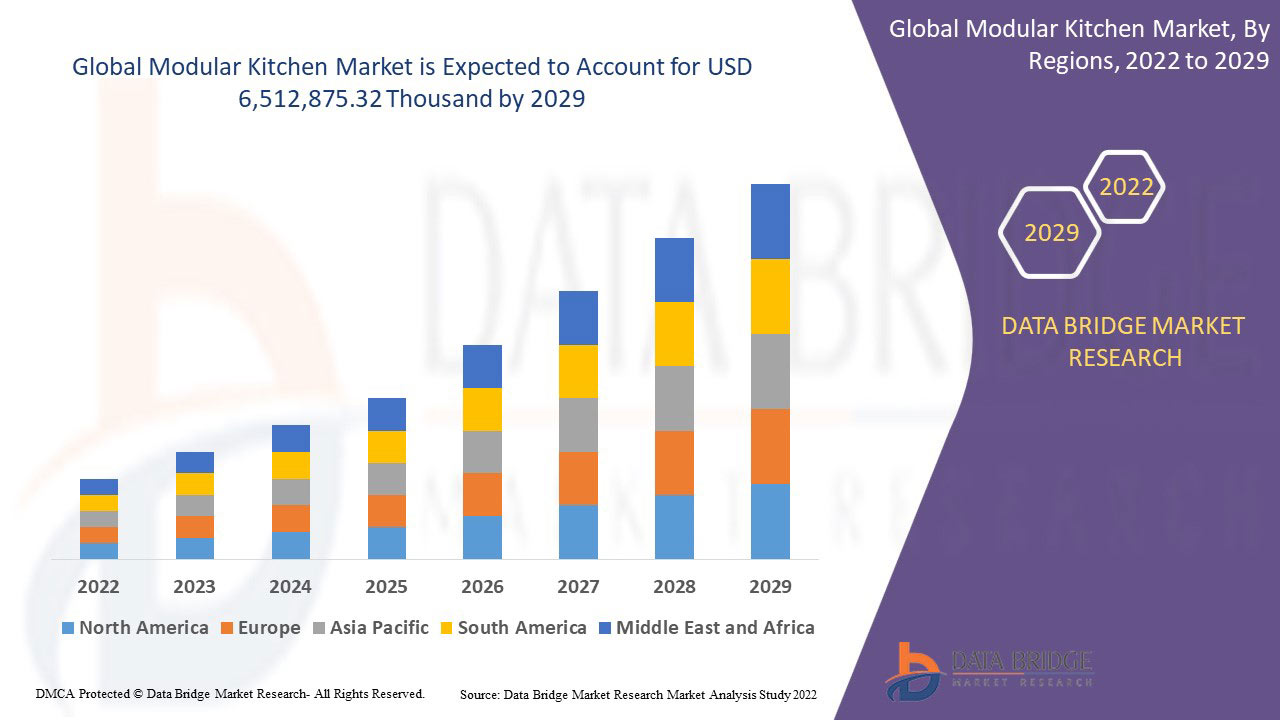Global Modular Kitchen Market
市场规模(十亿美元)
CAGR :
% 
 USD
4.78 Billion
USD
7.22 Billion
2023
2031
USD
4.78 Billion
USD
7.22 Billion
2023
2031
| 2024 –2031 | |
| USD 4.78 Billion | |
| USD 7.22 Billion | |
|
|
|
>全球模块化厨房市场细分,按产品(落地柜和壁柜)、布局(直线布局、L 形布局、U 形布局、平行布局、岛式厨房和 G 形)、原材料(木材、金属、纤维/塑料等)、应用(住宅和商业)、建筑(新建、翻新和维修)、分销渠道(线下和线上)– 行业趋势和预测到 2031 年
模块化厨房市场分析
模块化厨房市场正在经历显著增长,这得益于技术进步和创新设计方法。最近的趋势包括集成智能技术,例如支持物联网的家电,这提高了便利性和能源效率。这些家电可以远程控制,让房主可以监控使用情况并自动执行任务,从而优化厨房操作。
此外,3D 可视化软件正在彻底改变厨房设计,使消费者能够在安装前直观地看到他们的空间。这项技术不仅可以提高客户满意度,还可以减少设计错误,从而节省成本并高效完成项目。
可持续材料(如环保层压板和再生木材)越来越受欢迎,满足了人们对环保产品日益增长的需求。使用模块化组件可以实现可定制配置,满足不同的消费者偏好,并最大限度地提高城市环境中的空间效率。
在线零售和电子商务平台的增长也扩大了市场覆盖范围,为消费者提供了更广泛的模块化厨房解决方案。随着城市化和可支配收入的提高,在创新技术和不断变化的消费者生活方式的推动下,模块化厨房市场有望继续扩张。
模块化厨房市场规模
2023 年全球模块化厨房市场规模价值 47.8 亿美元,预计到 2031 年将达到 72.2 亿美元,2024 年至 2031 年预测期内的复合年增长率为 5.3%。除了对市场价值、增长率、细分、地理覆盖范围和主要参与者等市场情景的见解外,Data Bridge Market Research 策划的市场报告还包括深入的专家分析、定价分析、品牌份额分析、消费者调查、人口分析、供应链分析、价值链分析、原材料/消耗品概述、供应商选择标准、PESTLE 分析、波特分析和监管框架。
模块化厨房市场趋势
“智能厨房技术的兴起”
推动模块化厨房市场增长的一个具体趋势是智能厨房技术的整合。消费者越来越多地寻求创新解决方案,以提高烹饪和备餐的便利性和效率。智能厨房电器,如智能冰箱和烤箱,允许用户远程控制设置并接收通知,从而提高能源效率。例如,三星和 LG 等品牌推出了可与智能手机应用程序同步的联网电器,使用户可以从任何地方监控厨房。这项技术进步不仅吸引了精通技术的消费者,而且还提升了整体烹饪体验,大大促进了配备这些智能功能的模块化厨房的需求。
报告范围和模块化厨房市场细分
|
属性 |
模块化厨房关键市场洞察 |
|
涵盖的领域 |
|
|
覆盖国家 |
北美洲的美国、加拿大和墨西哥、德国、法国、英国、荷兰、瑞士、比利时、俄罗斯、意大利、西班牙、土耳其、欧洲其他地区、中国、日本、印度、韩国、新加坡、马来西亚、澳大利亚、泰国、印度尼西亚、菲律宾、亚太地区 (APAC) 的其他地区、沙特阿拉伯、阿联酋、南非、埃及、以色列、中东和非洲 (MEA) 的其他地区、巴西、阿根廷和南美洲其他地区 |
|
主要市场参与者 |
Nobia(瑞典)、Nobilia(德国)、Hettich Holding GmbH & Co. oHG(德国)、Häcker Küchen(德国)、Bulthaup GmbH & Co KG(德国)、Sleek International Pvt Ltd.(Asian Paints 的子公司)(印度)、SieMatic Möbelwerke GmbH & Co. KG(德国)、Alea Modular Kitchen(印度)、Easylife Kitchens(印度)、Godrej Interio(印度)、Kohler Co.(美国)、LINEADECOR(土耳其)、Lukwood Kitchen(印度)、Nexus Interio Private Limited(印度)、Pedini SpA(意大利)、Snaidero Rino Spa(意大利)和 Wudley Modulars(印度) |
|
市场机会 |
|
|
增值数据信息集 |
除了对市场价值、增长率、细分、地理覆盖范围和主要参与者等市场情景的见解之外,Data Bridge Market Research 策划的市场报告还包括深入的专家分析、定价分析、品牌份额分析、消费者调查、人口分析、供应链分析、价值链分析、原材料/消耗品概述、供应商选择标准、PESTLE 分析、波特分析和监管框架。 |
模块化厨房市场定义
模块化厨房是一种现代化的可定制厨房设计,采用预制单元或模块,可实现高效的空间管理和美观性。这些模块可以包括橱柜、抽屉、架子和电器,可以按照各种配置进行排列,以适应个人喜好和厨房布局。模块化厨房通常由胶合板、中密度纤维板或刨花板等材料制成,设计灵活,房主可以选择符合其风格的颜色、饰面和配件。它们也易于安装和更换,因此成为追求功能性和优雅性的现代家庭的热门选择。
模块化厨房市场动态
驱动程序
- 住宅建设和装修活动不断增长
住宅建筑和装修活动的激增极大地推动了模块化厨房市场的发展。随着房主寻求最大限度地利用空间并提高效率,模块化厨房变得越来越受欢迎。这些厨房设计适合各种布局,提供可定制的选项,以吸引现代消费者。例如,2022 年 4 月,Nobia 推出了其集团范围的设计理念 Nordic Nature,灵感来自北欧森林的宁静之美。最初于 2021 年由 Marbodal(瑞典)、Sigdal(挪威)和 A'la Carte(芬兰)推出,并于 2022 年与 HTH 和 Invita(丹麦)和 Magnet(英国)一起扩展。这种创新的设计方法不仅增强了厨房的美感,还旨在通过吸引寻求清新、自然氛围的消费者来提高销量。
- 消费者对节省空间和高效存储的需求日益增加
对节省空间和高效存储解决方案的需求不断增长,极大地推动了全球模块化厨房市场的增长。随着核心家庭的兴起,消费者越来越多地寻求能够最大限度地发挥功能、同时占用最小空间的厨房。海福乐和宜家等公司对此做出了回应,推出了模块化厨房解决方案,这些解决方案采用了光面和层压饰面,在优化存储的同时增强了美感。这些设计通常具有可定制的元素,例如抽屉、橱柜和微型隔间,让房主能够根据自己的特定需求定制厨房。这种适应性不仅符合当代设计趋势,而且满足了现代开放式生活空间的需求,从而增强了对模块化厨房的需求。
机会
- 由于消费者生活方式的改变,采用率不断提高
模块化厨房的日益普及反映了生活方式模式的改变,尤其是在人们花更多时间待在家中的后封锁时代。随着可支配收入的增加,消费者寻求宽敞、美观的厨房设计,以增强功能性和风格。例如,2022 年,Snaidero 推出了新品牌 MandiCasa,扩大了其产品组合,包括来自意大利顶级供应商的模块化厨柜、浴室柜、浴室和壁橱等各种高端产品。此次发布反映了 Snaidero 致力于提供高品质、时尚的家居解决方案,以满足不断变化的消费者偏好,增强其市场竞争力,同时在现代生活空间中推广意大利工艺和设计卓越。
- 科技进步
由于技术进步和创新产品的推出,模块化厨房行业正在经历显着增长。随着新参与者的进入,消费者可以从各种可定制的设计、布局和配件中进行选择,以满足他们的特定需求。例如,宜家等品牌已经集成了增强现实应用程序,以帮助客户在家中可视化厨房设置。此外,电子商务和社交媒体营销的兴起改变了消费者的购物方式,从而增加了在线销售额。随着可支配收入的增加和消费者对智能家居解决方案的认识不断提高,智能家电和环保材料等先进产品的机会不断扩大,推动市场增长。
限制/挑战
- 安装成本高
安装模块化厨房通常需要高昂的成本,特别是因为需要适当的通风系统。有效的通风对于排出烹饪油烟和确保新鲜空气循环至关重要。此要求通常涉及安装烟囱或排气扇,这会增加总体费用。此外,为了获得最佳通风效果,厨房必须有通往阳台或开放区域的门或窗户,这进一步增加了安装和设计的复杂性。这些额外的费用可能会阻止潜在买家,尤其是那些预算有限的买家,最终阻碍市场增长,因为消费者寻求更实惠的替代方案,这些替代方案需要更少的通风解决方案投资。
- 来自传统厨房的竞争
模块化厨房市场面临着来自传统厨房设计的激烈竞争,而传统厨房设计仍占据相当大的市场份额。在定制橱柜和当地工艺受到高度重视的地区,消费者往往更喜欢传统厨房的独特性和个性化。这种偏好可能源于文化影响、对定制解决方案的渴望,或对手工制作元素的更高品质的认知。因此,传统厨房的既有存在可能会限制模块化厨房的增长潜力,因为一些人群仍然不愿意采用预制选项,从而影响整体市场扩张。
本市场报告详细介绍了最新发展、贸易法规、进出口分析、生产分析、价值链优化、市场份额、国内和本地市场参与者的影响,分析了新兴收入领域的机会、市场法规的变化、战略市场增长分析、市场规模、类别市场增长、应用领域和主导地位、产品批准、产品发布、地域扩展、市场技术创新。如需获取更多市场信息,请联系 Data Bridge Market Research 获取分析师简报,我们的团队将帮助您做出明智的市场决策,实现市场增长。
模块化厨房市场范围
市场根据产品、布局、原材料、应用、结构和分销渠道进行细分。这些细分市场之间的增长将帮助您分析行业中增长缓慢的细分市场,并为用户提供有价值的市场概览和市场洞察,帮助他们做出战略决策,确定核心市场应用。
产品
- 落地柜
- 壁柜
布局
- 直线布局
- L 形布局
- U 型布局
- 平行布局
- 岛式厨房
- G 形
原料
- 木头
- 金属
- 纤维/塑料
- 其他的
应用
- 住宅
- 商业的
建造
- 新建筑
- 改造
- 维修
分销渠道
- 离线
- 在线的
模块化厨房市场区域分析
The market is analyzed and market size insights and trends are provided by product, layout, raw material, application, construction, and distribution channel as referenced above.
The countries covered in the market report are U.S., Canada, Mexico in North America, Germany, Sweden, Poland, Denmark, Italy, U.K., France, Spain, Netherland, Belgium, Switzerland, Turkey, Russia, Rest of Europe in Europe, Japan, China, India, South Korea, New Zealand, Vietnam, Australia, Singapore, Malaysia, Thailand, Indonesia, Philippines, Rest of Asia-Pacific (APAC) in Asia-Pacific (APAC), Brazil, Argentina, Rest of South America as a part of South America, U.A.E, Saudi Arabia, Oman, Qatar, Kuwait, South Africa, Rest of Middle East and Africa (MEA) as a part of Middle East and Africa (MEA).
Asia-Pacific is expected to dominate the market due to a rise in consumer spending on modular kitchens in the renovation of homes and furniture in the region. The rise in investments and initiatives towards construction activities for both commercial and residential is propelling the region's demand for modular kitchens.
The country section of the report also provides individual market impacting factors and changes in market regulation that impact the current and future trends of the market. Data points such as down-stream and upstream value chain analysis, technical trends and porter's five forces analysis, case studies are some of the pointers used to forecast the market scenario for individual countries. Also, the presence and availability of global brands and their challenges faced due to large or scarce competition from local and domestic brands, impact of domestic tariffs and trade routes are considered while providing forecast analysis of the country data.
Modular Kitchen Market Share
The market competitive landscape provides details by competitor. Details included are company overview, company financials, revenue generated, market potential, investment in research and development, new market initiatives, global presence, production sites and facilities, production capacities, company strengths and weaknesses, product launch, product width and breadth, application dominance. The above data points provided are only related to the companies' focus related to market.
Modular Kitchen Market Leaders Operating in the Market Are:
- Nobia (Sweden)
- Nobilia (Germany)
- Hettich Holding GmbH & Co. oHG (Germany)
- Häcker Küchen (Germany)
- Bulthaup GmbH & Co KG (Germany)
- Sleek International Pvt Ltd. (a subsidiary of Asian Paints) (India)
- SieMatic Möbelwerke GmbH & Co. KG (Germany)
- Alea Modular Kitchen (India)
- Easylife Kitchens (India)
- Godrej Interio (India)
- Kohler Co. (U.S.)
- LINEADECOR (Turkey)
- Lukwood Kitchen (India)
- Nexus Interio Private Limited (India)
- Pedini SpA (Italy)
- Snaidero Rino Spa (Italy)
- Wudley Modulars (India)
Latest Developments in Modular Kitchen Market
- 2022 年 11 月,TTK Prestige 的子公司 Ultrafresh Modular Solutions 在泰米尔纳德邦蒂鲁布尔开设了第八家工作室,占地约 1,200 平方英尺。这家新工作室体现了公司的“一站式购物”理念,展示了大量模块化厨房、衣柜和展示柜。该计划旨在通过在一个地点提供各种时尚实用的家居解决方案来提升客户体验
- 2023 年 4 月,Dona Modular Systems 在印度厨房大会上荣获“2023 年厨房零售商奖”,以表彰其创新的模块化厨房设计。这些高级厨房将欧洲美学与印度功能完美融合,吸引了当地消费者。该公司有效地满足了人们对现代厨房解决方案日益增长的需求,受到欧洲室内设计时尚精致风格的影响,从而加强了其市场影响力
- 2022 年 4 月,Nobia 推出了集团范围内的设计理念“北欧自然”,灵感来自北欧森林的宁静之美。该理念最初于 2021 年由 Marbodal(瑞典)、Sigdal(挪威)和 A'la Carte(芬兰)推出,并于 2022 年与 HTH 和 Invita(丹麦)以及 Magnet(英国)一起扩展。这种创新的设计方法不仅增强了厨房的美感,还旨在通过吸引寻求清新、自然氛围的消费者来提高销量
- 2022 年,Snaidero 推出了新品牌 MandiCasa,扩大了其产品组合,包括来自意大利顶级供应商的各种高端产品,例如厨柜、浴室柜、浴室和壁橱。此次发布反映了 Snaidero 致力于提供高品质、时尚的家居解决方案,以满足不断变化的消费者偏好,增强其市场竞争力,同时在现代生活空间中推广意大利工艺和卓越设计
- 2021 年 5 月,Hettich Holding GmbH & Co. oHG 凭借其 AvoriTech 抽屉系统获得了备受推崇的 iF 设计奖(厨房类)。该设计采用纤薄的 8 毫米抽屉侧面轮廓和后面板,将美学优雅与高品质材料融为一体。这一殊荣将提升该品牌在消费者中的知名度和声誉,展现了 Hettich 对厨房解决方案创新设计和功能的承诺
SKU-
Get online access to the report on the World's First Market Intelligence Cloud
- Interactive Data Analysis Dashboard
- Company Analysis Dashboard for high growth potential opportunities
- Research Analyst Access for customization & queries
- Competitor Analysis with Interactive dashboard
- Latest News, Updates & Trend analysis
- Harness the Power of Benchmark Analysis for Comprehensive Competitor Tracking
研究方法
数据收集和基准年分析是使用具有大样本量的数据收集模块完成的。该阶段包括通过各种来源和策略获取市场信息或相关数据。它包括提前检查和规划从过去获得的所有数据。它同样包括检查不同信息源中出现的信息不一致。使用市场统计和连贯模型分析和估计市场数据。此外,市场份额分析和关键趋势分析是市场报告中的主要成功因素。要了解更多信息,请请求分析师致电或下拉您的询问。
DBMR 研究团队使用的关键研究方法是数据三角测量,其中包括数据挖掘、数据变量对市场影响的分析和主要(行业专家)验证。数据模型包括供应商定位网格、市场时间线分析、市场概览和指南、公司定位网格、专利分析、定价分析、公司市场份额分析、测量标准、全球与区域和供应商份额分析。要了解有关研究方法的更多信息,请向我们的行业专家咨询。
可定制
Data Bridge Market Research 是高级形成性研究领域的领导者。我们为向现有和新客户提供符合其目标的数据和分析而感到自豪。报告可定制,包括目标品牌的价格趋势分析、了解其他国家的市场(索取国家列表)、临床试验结果数据、文献综述、翻新市场和产品基础分析。目标竞争对手的市场分析可以从基于技术的分析到市场组合策略进行分析。我们可以按照您所需的格式和数据样式添加您需要的任意数量的竞争对手数据。我们的分析师团队还可以为您提供原始 Excel 文件数据透视表(事实手册)中的数据,或者可以帮助您根据报告中的数据集创建演示文稿。















